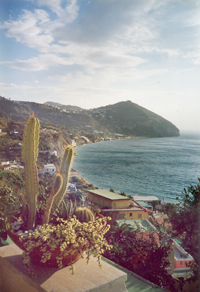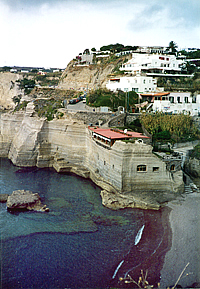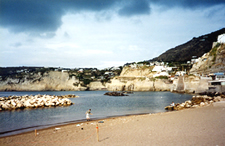|

by
Amanda Castleman
 |
| The
view from Casa Eugenio's, a pensione gem. |
Salty
gusts rose off the pool, freezing white in the December chill,
then fading into the turquoise sky. Vents spat scalding jets
of water, heated deep within the earth. I snuggled under the
surface, listening to the smack of waves and piping birds below.
Now this was a Happy New Year. Buon'anno, as the Italians
say.
Indeed
they were saying it every 30 seconds or so, there on Ischia,
an island in the Bay of Naples. The festive spirit ran strong
at the cliff-top spa, aided by tangy shots of yellow liquor,
sweetly sour limoncello. Children skidded and shrilled on
wet pathways, a puppy yapped from his wire cage and strangers
chatted, embraced. Buon'anno! Auguri!
Eager
to soak up Italian culture, I lingered in the pools, eavesdropping.
It wasn't difficult. People spoke very loudly, like actors
playing to the cheap seats. Or perhaps they just wanted to
be heard above all that surf, seagulls and shrieking offspring.
Merry
groups crowded into the boiling plunge bath. Without fail,
as a toe immersed, the Italians announced "C'e caldo!"
How hot!
Or,
playing with understatement, "C'e freddo!" So cold!
At
some point, I comforted myself, it will stop. Someone, somewhere,
will tweak the phrase, branch out, innovate. But no, for two
days I wallowed in the warmth, until caldo and freddo
were seared into my brain. Most incredibly, each tired
phrase was greeted with a fresh bout of giggling. C'e freddo!
Now that's funny!
It's
not what you say, but the way that you say it, I realized.
The Italians chattered to be friendly, not to express some
burning insight. The impulse was purely jolly. Hey look! All
those chumps are freezing up there on the ski slopes and we're
sipping espresso in our bathing suits. La Dolce Vita!
We
had reason to be smug. The island is lush, teaming with bougainvillaea
and greenery, even in winter. The scenery is spectacular (remember
the cinematic vistas in The Talented Mr. Ripley?).
Embraced by the Tyrrhenian Sea, Ischia remains a well-kept
secret, nearly unspoilt by tourist taint.
Of
course, word gets around. Celebrities from Michelangelo Buonarroti
to Elizabeth Taylor have sought refuge there. Norwegian playwright
Henrik Ibsen once pottered about in Casamicciola, the town
where Guiseppe Garibaldi recovered from his war wounds.
Even
mythological heroes took a break in Ischia. Ulysses visited
the king on Castiglione hill, while Aphrodite dipped into
the thermal waters. Aeneas beached his boat in Lacco Ameno,
where centuries later the remains of Santa Restituta washed
ashore.
The
Ancient Greeks fell for its charms, establishing their first
western colony, Pithekoussai, in 770 BC. They brought along
the fabled Cup of Nestor, now housed in the Lacco Ameno Archaeological
Museum. The vessel, created in Rhodes, is inscribed with a
quotation from the Iliad: "I am the delicious cup ...
of Nestor. Whoever drinks from this cup, straightaway that
man the desire of beautiful-crowned Aphrodite will seize."
 |
| Lo
Scoglio restaurant is carved into a sea stack, overlooking
an illuminated harbor. |
The
balmy peaceful island - with its strategic location - was
an invader's dream. And they flocked in: the Oscans, Romans,
Eruli, Ostrogoths, Saracen pirates, Neapolitan dukes, Swabian
emperors, Normans, French and Spanish, even the ferocious
Barbarossa, pasha of the Ottoman troops. The Bourbons and
Napoleon reigned until Garibaldi's troops made the island
part of Italy in 1860. Barring German occupation during WWII,
the area has escaped ravage and plunder in recent decades.
Tourism
ignited in the 1950s, when film producer Angelo Rizzoli poured
money into luxury hotels. "Ischia, the island of eternal
youth", was his slogan, promoting the warm radioactive
waters. Soon health and beauty clinics sprang up, treating
anything from pimples to rheumatism, arthritis to obesity
and mysterious "neuro-vegetative disorders".
The
area is ideal for spas with 103 natural hot springs and a
balmy Mediterranean climate, averaging 45-55 degrees in January.
Warm water vents make swimming possible most of the year,
especially after basking in a nearby fumarole (plume of steam).
At the famous Maronti Beach, the volcanic sand scorches bare
feet.
Italian tourists often bury eggs in the hot earth, which
emerge hard-boiled and reeking of sulphur, passed among the
cheerful crowd.
The
thermal baths have garnered Destination Reviews since Roman times.
Pliny and Strabo heartily endorsed a plunge, despite the threat
of volcanic eruptions. Virgil was more leery. He warned that
Typhoeus, an angry monster with 100 serpent heads, lurked
below the rocks, spurting lava from Tartarus.
Modern
scientists offer a more mundane explanation. Ten million years
ago, the Italian peninsula and its islands were bound together.
As they split apart, the stretching and thinning of the earth's
crust left deep faults, prone to magma eruptions.
Early
colonies were devastated by lava flows, and the original port
was entirely submerged in the 6th century BC. The last eruption
gave the town of Fiaiano its name, 'little flame', in 1301.
The area's 50 volcanoes have been dormant ever since, though
Ischia is still rocked by earthquakes.
This
mild activity, fuelling the hot springs, is welcomed. A 16th-century
physician, Jasolino, investigated the island's therapeutic
properties. He concluded that "the waters are hot and
shining. It aids the kidneys and heals liver sports. The water
can be used in place of all the baths in Avignon".
Indeed,
the alkaline springs contain sulphur, iodine, chlorine, iron,
potassium and other elements, said to improve health. The
Gurgitello pools include Stomacho (tastes like capon broth,
considered useful for sterility), Denti (for the gums) and
Aurifero (thought to contain real gold).
 |
| Fishermen
and children frequent the beaches of Sant'Angelo. |
Italians
still place great faith in these mineral baths and the "noble
gas radon, which exalts physiological functions," according
to Ischia's website (www.ischiaonline.it).
The island remains a popular retreat for natives, though overshadowed
by its glamorous neighbour Capri. A handful of international
visitors wander through - mostly German - and are greeted
warmly. Ischia isn't jaded yet, embracing tourism without
succumbing to it.
Hopefully
the welcoming air won't fade as the island grows more popular.
Last year, Ischia celebrated the centenary of its famous adopted
son, British composer William Walton. England fell into a
frenzy, churning out concerts, a festival and four books.
America has followed suit, rediscovering his lyricism, jazzy
harmonies and stately coronation march.
As
his reputation revives, travellers are following his footsteps
to Ischia. He retired there in 1949, world-weary and skeptical
of his own genius, with his young Argentinian bride.
Until
Walton's death in '83, he polished a handful of pieces and
gardened. It was a plot of earth worthy of any talent. Landscaper
Russell Page transformed a rough valley - dismissed as a quarry
- into a tropical paradise. Ferns, camellias and water lilies
blanket the slopes, home to over 1,000 rare and exotic plants.
Even its name is exquisite: La Mortella, the local word for
myrtle. Not bad for an estate "built on the never-never,
with the help of IOUs from the local grocer".
The
Lady Walton now welcomes curious visitors from April to October,
often in person, chatting volubly. The small museum houses
photographs, many snapped by scene-setter Cecil Beaton. A
concert room cuts deep into the cliff-face and the tea room
overlooks the Lotus pool. Young musicians offer afternoon
concerts on the weekends.
La
Mortella is the serene face of Ischia, far from the jolly
splashing and cooing in the cliff-top spas. Yet both offer
a glimpse of the true Italia, the secret delights off the
tourist track, the sweet blend of culture, courtesy and creature
comforts. Catch it while it's hot. C'e caldo!
IF
YOU GO.... |
Getting
there
The nearest major airport is Naples Capodichino, though
most visitors fly through Rome Leonardo da Vinci. Take
an Intercity (€12) or slightly faster Eurostar
train from Termini station (€22).
Connections
are smoother through Naples Mergellina station, just
200 feet from the waterfront. Linee Lauro runs to Ischia
Porto (081.761.4090), while SNAV runs to Casamicciola
(081.761.2348). A hydrofoil tickets costs about €12
one-way; the slower ferry just €6.
Travellers
arriving in Naples Centrale station should buy a bus
ticket at a news-stand (€.77). Cross the manic
piazza to reach Tram 1's stop. Ride down to the water,
then hop off at the ferry docks (Molo Beverello) opposite
the decrepit castle. |
IF
YOU GO.... |
On
Ischia, the CS1bus runs through both port towns and
turns around at Cava Grado outside Sant'Angelo: Look
for the Tropical Garden sign (€1.20). Or catch
a beribboned mini-taxi for around €20. Half-day
transport strikes are common on Ischia, so always double-check
schedules.
Best
base
The fishing village of Sant'Angelo is the best base
for exploring Ischia. Only mules, pedestrians and three-wheeled
mini-taxis can venture up the picturesque slopes. The
safe streets encourage a colony of beautiful and brazen
cats, who lounge on the sun-warmed flagstones. Artists,
such as painter Werner Gilles, flocked there in the
50s, declaring it "the most beautiful place in
the world".
The
small harbour contains bars, boutiques, boats and a
narrow isthmus, stretching across to one of the Tyrrhenian
Sea's most distinctive landmarks. The Roja - "the
little island of Sant'Angelo" - is a volcanic cone,
capped with the remains of a tower and Benedictine monastery
(both destroyed when Nelson's English fleet shelled
the area in 1809).
Visitors
can clamber onto the islet's wildly eroded lower slopes
or catch a water taxi on the isthmus. The Maronti Beach
fumarole (steam plume) and ancient Roman baths at Cava
Scura are two popular destinations, though longer boat
tours also depart from the port.
Where
to stay
Casa Gerado sits in a lush, tangled garden, with a conservatory
for chilly days. The family rents both rooms and apartments
(€516-826/week). Via Cava Grado. Tel and Fax: 081.907.790.
Web: www.casagerardo.it Double €48-88 with breakfast,
discount at the Tropical spa.
Pensione
Eugenio offers simple en-suite rooms with scenic terraces
and a jolly, homey atmosphere. It's the best value for
money, especially if you can coax an opera tune from
Eugenio. Via Madonnella 21. Tel: 081.999.722. Fax: 081.904.900.
Web: www.casaeugenio.com.
Double €50 with breakfast.
Hotel
Lorely is a sleek modern building, dazzling snow-white
against the greenery and blue sea. It boasts a thermal
pool, solarium and views of Capri. Via Sant'Angelo,
50/A. Tel: 081.999.313. Fax: 081.999.065 Web: www.hotelloreley.it Double €86-122 with breakfast. Half-board €114-150.
Hotel
San Michele is the town's grand dame hotel, set on exquisite
grounds, with stables, an internal spa, live folk music
and an internet point. Tel: 081.999.276. Fax: 081.999.149.
Web: www.hoteltermesanmichele.it Double €206-240 half-board (add €20 for full).
Where
to eat
Pizzeria da Pasquale, Via Sant'Angelo Coatro 79 (081.904.208).
Huge wooden benches and rope lamps make this informal
pizzeria quite cozy. Entrees run €4-8.
Lo
Scoglio, Via Cava Ruffano (081.999.529). This cheerful
restaurant, overlooking an illuminated cove, is actually
carved into a sea stack. Huge portions of simple Southern
Italian cooking with entrees from €6-15. |
IF
YOU GO.... |
Ristorante
Bar dal Pescatore, Piazzetta Marina Sant'Angelo (081.904.267).
Elegant wrought iron-work and fish mosaics enchant tourists
by the bay. A hot drink costs €4-6, entrees €8-22.
Ristorante
La Tavernetta del Pirata, Via S. Angelo (081.999.251).
Pirate motif and piratical prices, but there's no better
place for a post-spa cocktail. This waterfront bar has
cheerful music, substantial complimentary tapas and
wicker chairs overlooking the harbour. Mixed drinks
€7-12.
Where
to soak
Casual spa-goers should book separate accommodation,
then visit one of the thermal parks on a day ticket
(€12-20). Some hotels have in-house facilities,
which are generally more elite and less spectacular.
Long-term cures and specific treatments should be arranged
in advance - even a basic massage requires a reservation.
Locals
prefer the Aphrodite Apollon, where baths cascade down
a cliff to the hot sand beach (Via Fondolillo; 081.999.219; www.aphrodite.it).
The posher Tropical is open off-season (Via Cava Ruffano;
081.999.242), but forces clients to wear bathing caps,
ruining the hedonistic glamour.
Ischian
spas are best visited between early April and the end
of November, but some remain open throughout the winter.
For
more information
Whet your appetite at www.ischiaonline.it.
The tourist office is just beside the Ischia Porto docks
(Via Lasolino, Banchina Porto Salvo; 081.991.146). A
beaming multi-lingual lady staffs the Sant'Angelo information
centre (Cava Grado). She also sells guidebooks and advance
tickets to Spa Aphrodite Apollon, which include a free
water taxi from the town's docks.
Ischiataxi
offers airport transfers from Rome (€360) and Naples
(€130) and island tours (€100). Tel: 081.992.651.
Fax: 081.333.4869. Web: www.ischiataxi.it Salty dogs should contact Ischiabarche to charter boats
or book excursions. Via Pontano 7, 80077 Ischia. Tel
& Fax: 081.984.854 Web: www.ischiabarche.it
William
Walton's garden, La Mortella, in Forio is open Tuesday,
Thursday, Saturday and Sunday from 9am to 7pm, admission
€8. April-October. |
|